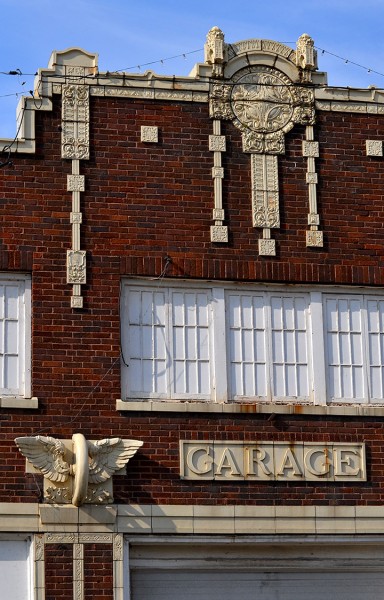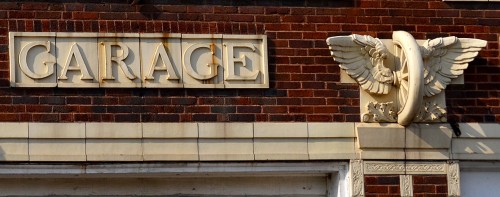 As I travel across this great land, particularly in older sections of towns, I am struck by something: buildings used to have soul and were built as monuments to the people and businesses that inhabited them.
As I travel across this great land, particularly in older sections of towns, I am struck by something: buildings used to have soul and were built as monuments to the people and businesses that inhabited them.
After Curator Jessica and I gawked at Big Muskie’s monster dragline bucket and marveled at the Muskingum River levels in the Great Flood of 1913, we crossed over the river into McConnelsville, Ohio.
We hadn’t gone too far down West Main Street when I abruptly whipped into a gas station to take a photo of the front of this beautiful old garage.
Winged wheels
 Something looked familiar about the winged wheels. Then, it dawned on me: a subtle variation of that was the symbol of the Ohio State Highway Patrol. (Click on the photos to make them larger.)
Something looked familiar about the winged wheels. Then, it dawned on me: a subtle variation of that was the symbol of the Ohio State Highway Patrol. (Click on the photos to make them larger.)
Whoever built this garage wanted to let everybody in town know that this wasn’t a blacksmith’s stable or some shadetree mechanic – this was a place where the automobile was celebrated.
I get the same feeling when I drive around in St. Louis and see buildings that may not have ornate artwork on them, but still carry the name of the owner or business because it was expected to last.
Where in Cape was such a building?
I’m trying to think of any buildings like that in Cape. I’d have to nominate the old Farmers and Merchants Bank at the corner of Sprigg and Good Hope whose stone columns said “bank” as soon as you saw them.
The Boat House across from Capaha Park would be another.
More?

Ken, there’s an old building beside the railroad tracks in Painton, Mo. I thought it HAD to be built as something lofty, judging from the brick construction and the cupola–but, when I did a story on Capt. Painton’s little village, founded around 1920, I discovered that the building was always a garage.
Al Painton explained that his grandfather had a penchant for architecture, so several of his buildings were beautiful. Unfortunately, not all of them are still standing.
Painton was a sawmill town, before the trees were all gone and they switched to farming. The village was planned out in blocks and had about 80 homes, most of which are gone. Capt. Painton had electricity installed in the town before nearby Advance, which was founded in 1881.
The most impressive thing to me is that he put his workers on a sort of Social Security, even before it was introduced nation-wide. If they worked for him, they had a home for the rest of their lives.
He was an amazing man.
Madeline, I’ve talked with Al Painton several times when I’ve been at the airport flying with Ernie Chiles, but I’ve never gotten around to doing a real interview with him.
It’s one of those things I need to do sooner than later. Thanks for the nudge.
The Glenn House in Cape for sure. Academic Hall at SEMO is another….now let me think….after my morning nap.
Consider these:
Hechts
The Alverado
The Houck mini mansion
the old First National Bank
the Opera house
the Southeast Missourian building
the Oliver-Leming house, after the portico was added
Homewood
How about Cheney Hall on the SEMO Campus? Built in 1939 as part of a WPA Project, it turns 75 this year, and still serves as home to more than 100 students each year.
PHOTO:
http://semissouristate.smugmug.com/Loc/Buildings/Cheney-Residence-Hall/i-SNxqB3x/A
Must include the original CGCC club house
The old “Tipton laundry” on sprigg st comes to mind